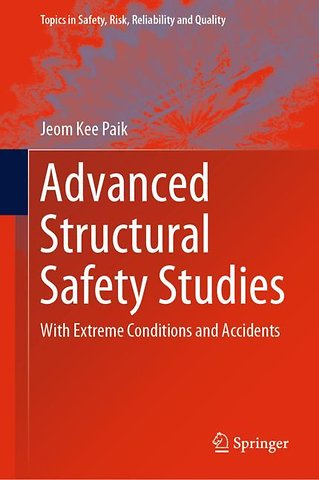Advanced Structural Safety Studies
With Extreme Conditions and Accidents
Gebonden Engels 2019 9789811382444Samenvatting
This book describes principles, industry practices and evolutionary methodologies for advanced safety studies, which are helpful in effectively managing volatile, uncertain, complex, and ambiguous (VUCA) environments within the framework of quantitative risk assessment and management and associated with the safety and resilience of structures and infrastructures with tolerance against various types of extreme conditions and accidents such as fires, explosions, collisions and grounding. It presents advanced computational models for characterizing structural actions and their effects in extreme and accidental conditions, which are highly nonlinear and non-Gaussian in association with multiple physical processes, multiple scales, and multiple criteria. Probabilistic scenario selection practices and applications are presented. Engineering practices for structural crashworthiness analysis in extreme conditions and accidents are described. Multidisciplinary approaches involving advanced computational models and large-scale physical model testing are emphasized. The book will be useful to students at a post-graduate level as well as researchers and practicing engineers.
Specificaties
Lezersrecensies
Inhoudsopgave
<p>5. Safety Assessment of Damaged Structures<br>5.1 Introduction<br>5.2 Residual Strength-Damage Index Diagram<br>5.3 Hull Collapse-Based Safety Assessment of Ships Damaged by Grounding<br>5.4 Rapid Planning of Rescue and Salvage Operations<br>References<br><br>6. Computational Models for Ship Structural Load Analysis in Ocean Waves<br>6.1 Introduction<br>6.2 Methods for Determining the Structural Loads of Ships in Ocean Waves<br>6.3 Design Wave Loads of a Very Large Crude Oil Carrier<br>6.4 Design Wave Loads of a 9,300-TEU Containership<br>6.5 Design Wave Loads of a 22,000-TEU Containership<br>6.6 Design Wave Loads of a 25,000-TEU Containership<br>6.7 Comparison of Design Wave Loads Between Ships of Different Sizes<br>References<br><br>7. Computational Models for Offshore Structural Load Analysis in Collisions<br>7.1 Introduction<br>7.2 Methods for Determining the Structural Loads of Offshore Platforms in Collisions<br>7.3 Structural Collision Loads of a Fixed Type Offshore Platform<br>References<br><br>8. Computational Models for Gas Cloud Temperature Analysis in Fires<br>8.1 Introduction<br>8.2 Industry Fire Curves<br>8.3 Gas Cloud Temperatures of Steel and Concrete Tubular Members in Jet Fire<br>8.4 Gas Cloud Temperatures in Jet Fire Caused by the Combustion of Propane Gases<br>8.5 Convergence Study in Fire Computational Fluid Dynamics Modeling Techniques<br>References<br><br>9. Computational Models for Blast Pressure Load Analysis in Explosions<br>9.1 Introduction<br>9.2 Industry Practices of Blast Pressure Loads<br>9.3 Analysis of Gas Dispersion<br>9.4 Analysis of Gas Explosions<br>9.5 Effects of Structural Congestion and Surrounding Obstacles<br>References<br><br>10. Computational Models for Nonlinear Structural Response Analysis in Extreme Loads<br>10.1 Introduction<br>10.2 Incremental Galerkin Method<br>10.3 Intelligent Supersize Finite Element Method<br>10.4 Nonlinear Finite Element Method<br>References<br><br>11. Computational Models for Structural Crashworthiness Analysis in Collisions and Grounding<br>11.1 Introduction<br>11.2 Material Property Modeling<br>11.3 Type of Finite Elements<br>11.4 Size of Finite Elements<br>11.5 Strain-Rate Effect Modeling<br>11.6 Contact Problem Modeling<br>11.7 Friction Effect Modeling<br>11.8 Surrounding Water Effect Modeling<br>11.9 Modeling the Interaction Effects between Striking and Struck Bodies<br>11.10 Impact Response Modeling at Low Temperatures<br>References<br><br>12. Computational Models for Structural Crashworthiness Analysis in Fires<br>12.1 Introduction<br>12.2 Nonlinear Finite Element Method Modeling<br>12.3 Automated Export of Computational Fluid Dynamics Simulations to Heat Transfer Analysis<br>12.4 Heat Transfer Analysis Models Without Passive Fire Protection<br>12.5 Heat Transfer Analysis Models with Passive Fire Protection<br>12.6 Combined Thermal and Structural Response Analysis Models<br>12.7 Effects of Heating Rate<br>12.8 Effects of Fire Loading Path <br>12.9 Effects of the Interaction Between Heat Transfer and Structural Response<br>References<br><br>13. Computational Models for Structural Crashworthiness Analysis in Explosions<br>13.1 Introduction<br>13.2 Nonlinear Finite Element Method Modeling<br>13.3 Topside Module of a Floating, Production, Storage, and Offloading Unit<br>13.4 Further Considerations<br>References <br><br>14. Quantitative Collision Risk Assessment and Management<br>14.1 Introduction<br>14.2 Procedure for Assessing Collision Risk<br>14.3 Selection of Collision Scenarios<br>14.4 Analysis of Collision Frequency<br>14.5 Analysis of Collision Consequence<br>14.6 Calculation of Collision Risk<br>14.7 Collision Risk Exceedance Diagrams<br>14.8 Risk of Hull Collapse Followed by Total Loss<br>14.9 Collision Risk Management<br>References<br><br>15. Quantitative Grounding Risk Assessment and Management<br>15.1 Introduction<br>15.2 Procedure for Assessing Grounding Risk<br>15.3 Methods for Assessing Ship Grounding Risk<br>15.4 Analysis of Grounding Frequency<br>15.5 Analysis of Grounding Consequence<br>15.6 Calculation of Grounding Risk<br>15.7 Grounding Risk Exceedance Diagrams<br>15.8 Risk to Hull Collapse Followed by Total Loss<br>15.9 Grounding Risk Management<br>References<br><br>16. Quantitative Fire Risk Assessment and Management<br>16.1 Introduction<br>16.2 Fundamentals of Fire Safety Engineering<br>16.3 Procedure for Assessing Fire Risk<br>16.4 Selection of Fire Scenarios<br>16.5 Analysis of Fire Frequency<br>16.6 Analysis of Fire Loads<br>16.7 Analysis of Fire Consequences<br>16.8 Calculation of Fire Risk\<br>16.9 Fire Risk Exceedance Diagrams<br>16.10 Fire Risk Management<br>References<br><br>17. Quantitative Explosion Risk Assessment and Management<br>17.1 Introduction<br>17.2 Procedure for Assessing Explosion Risk<br>17.3 Selection of Gas Dispersion Scenarios<br>17.4 Analysis of Gas Dispersion<br>17.5 Selection of Explosion Scenarios<br>17.6 Analysis of Explosion Frequency<br>17.7 Analysis of Explosion Loads<br>17.8 Analysis of Explosion Consequences<br>17.9 Calculation of Explosion Risk<br>17.10 Explosion Risk Management<br>References<br><br>18. Facilities for Physical Model Testing<br>18.1 Introduction<br>18.2 Similarity Laws for Structural Mechanics Model Testing<br>18.3 Scaling Laws for Hydrodynamic Model Testing<br>18.4 Experimental Definition of Material Properties<br>18.5 Measurements of Fabrication-Related Initial Imperfections<br>18.6 Structural Failure Tests<br>18.7 Dropped Object Testing<br>18.8 Furnace Fire Tests<br>18.9 Fire Collapse Tests<br>18.10 Indoor Fire Tests<br>18.11 Outdoor Fire/Explosion Tests<br>18.12 Blast Wall Tests<br>18.13 Hyperbaric Pressure Tests<br>References<br><br>Appendices</p><p></p>
<p>A.1 Latin Hypercube Sampling Program</p>
<p>A.2 Passive Fire Protection Materials</p>
<p>A.3 SI Units</p>
<p>A.3.1 SI Unit Prefixes</p>
<p>A.3.2 Conversion Factors<br><br>Index</p>
Rubrieken
- advisering
- algemeen management
- coaching en trainen
- communicatie en media
- economie
- financieel management
- inkoop en logistiek
- internet en social media
- it-management / ict
- juridisch
- leiderschap
- marketing
- mens en maatschappij
- non-profit
- ondernemen
- organisatiekunde
- personal finance
- personeelsmanagement
- persoonlijke effectiviteit
- projectmanagement
- psychologie
- reclame en verkoop
- strategisch management
- verandermanagement
- werk en loopbaan

